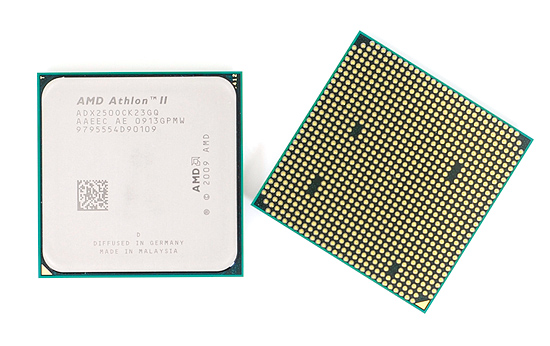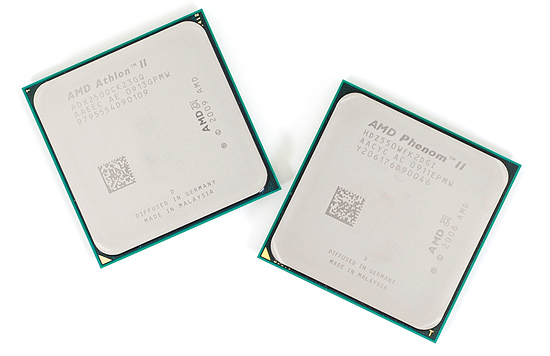The Athlon II X2 & Phenom II X2: 45nm Dual-Core from AMD
by Anand Lal Shimpi on June 2, 2009 12:00 AM EST- Posted in
- CPUs
“AMD in many cases delivers greater performance than the similarly priced Intel CPUs, but not nearly a large enough performance gap to make up for the difference in die size. Again, great for consumers, but potentially painful for AMD in the long run. As yields improve AMD should be able to make more of these cores members of the 900 family, but without a separate, smaller die there will still be economic inefficiencies at the lower end.”
“AMD’s Phenom II is very competitive, but the strategy does not have much long term staying power. AMD needs to introduce smaller die versions of its CPUs soon.”
Ask and you shall receive, right?
Intel did a bang up job tarnishing the Pentium name with its clock speed rampage during the Pentium 4 days, but the Athlon brand still holds a special place in our hearts.
This is the Athlon II, and it’s exactly what I’ve been asking for:

The Athlon II X2, to be specific, is a 45nm monolithic dual-core processor. While the most recent Athlon X2s are derivatives of the original Phenom architecture, the Athlon II is based on the new and improved Phenom II architecture.

The name lives on
Take two Phenom II cores, increase their L2 caches to 1MB, leave out the L3 and you’ve got an Athlon II. The entire die measures only 117.5 mm^2 and is made up of a meager 234 million transistors. The table below compares the Athlon II’s die size to other competing parts:
| Processor | Cores | Manufacturing Process | L1 Cache | L2 Cache | L3 Cache | Die Size | Transistor Count |
| AMD Phenom II X2 | 2 | 45nm | 128KB per core | 1MB | 6MB | 258 mm2 | 758M |
| AMD Athlon II X2 | 2 | 45nm | 128KB per core | 1MB per core | 0MB | 117 mm2 | 234M |
| AMD Athlon X2 | 2 | 65nm | 128KB per core | 512KB per core | 2MB | 285 mm2 | 450M |
| AMD Athlon 64 X2 | 2 | 65nm | 128KB per core | 512KB per core | 0MB | 126 mm2 | 154M |
| Intel Pentium for Desktop | 2 | 45nm | 64KB per core | 2MB | 0MB | 82 mm2 | 228M |
The new Athlon II is actually AMD’s smallest dual core processor ever, even smaller than the original Athlon 64 X2. It’s also AMD’s first 45nm dual-core processor. It’s also AMD’s first Socket-AM3 processor to carry the Athlon brand (ok, I’ll stop). As an AM3 chip it will work in both AM3 and AM2+ motherboards, just like the Phenom II.
The Athlon II is only launching with one model today the 3.0GHz Athlon II X2 250. Priced at $87, it’s likely that we won’t see more Athlon II X2s until AMD is ready to further switch its lineup over to 45nm in order to keep up with demand.
The Phenom II X2 550 BE
We actually get two new dual-core chips today, the second is the new Phenom II X2 550 Black Edition. Like all of the other chips in the Phenom II lineup, the X2 550 is simply a die-harvested Phenom II X4 part. In other words, what we have is a quad-core Phenom II with two of its cores disabled. Given that it’s still fairly early in GlobalFoundries’ 45nm manufacturing process, it makes sense to see so many harvested parts. I would expect these Phenom II X2 and perhaps even the X3 derivatives to either disappear or shift out of the limelight as AMD’s yields improve.

Because it’s based on the quad-core Phenom II processor, the X2 550 BE has a full 6MB L3 cache that the two cores can share. The L2 caches are still stuck at 512KB but with a large 6MB L3, there’s very little to complain about. The unlocked Black Edition part runs at 3.1GHz and retails for $102.
Availability and New Energy Efficient Phenom IIs
AMD is expecting availability for both of these parts in the next week or so.

The table below shows AMD’s new lineup with these two chips. Note that I’ve also included data on the Phenom II X4 905e and the Phenom II X3 705e. These two CPUs run at 2.5GHz and have a 65W TDP, down from 125W and 95W for all previous AM3 parts.
| Processor | Cores | Clock Speed | un-core Clock | L2 Cache | L3 Cache | TDP | Price |
| AMD Phenom II X4 955 BE | 4 | 3.2GHz | 2.0GHz | 2MB | 6MB | 125W | $245 |
| AMD Phenom II X4 945 | 4 | 3.0GHz | 2.0GHz | 2MB | 6MB | 125W | $225 |
| AMD Phenom II X4 940 BE | 4 | 3.0GHz | 1.8GHz | 2MB | 6MB | 125W | $225 |
| AMD Phenom II X4 920 | 4 | 2.8GHz | 1.8GHz | 2MB | 6MB | 125W | $195 |
| AMD Phenom II X4 910 | 4 | 2.6GHz | 2.0GHz | 2MB | 6MB | 95W | $??? |
| AMD Phenom II X4 905e | 4 | 2.5GHz | 2.0GHz | 2MB | 6MB | 65W | $195 |
| AMD Phenom II X4 810 | 4 | 2.6GHz | 2.0GHz | 2MB | 4MB | 95W | $175 |
| AMD Phenom 9950 | 4 | 2.6GHz | 2.0GHz | 2MB | 2MB | 140W | $173 |
| AMD Phenom II X4 805 | 4 | 2.5GHz | 2.0GHz | 2MB | 4MB | 95W | $??? |
| AMD Phenom II X3 720 BE | 3 | 2.8GHz | 2.0GHz | 1.5MB | 6MB | 95W | $145 |
| AMD Phenom II X3 710 | 3 | 2.6GHz | 2.0GHz | 1.5MB | 6MB | 95W | $125 |
| AMD Phenom II X3 705e | 3 | 2.5GHz | 2.0GHz | 1.5MB | 6MB | 65W | $125 |
| AMD Phenom II X2 550 BE | 2 | 3.1GHz | 2.0GHz | 1MB | 6MB | 80W | $102 |
| AMD Athlon II X2 250 | 2 | 3.0GHz | 2.0GHz | 2MB | 0MB | 65W | $87 |
| AMD Athlon X2 7850 | 2 | 2.8GHz | 1.8GHz | 1MB | 2MB | 95W | $69 |
And just for kicks here's a specs table with both AMD and Intel CPUs in it:
| Processor | Cores | Manufacturing Process | L1 Cache | L2 Cache | L3 Cache | Die Size | Transistor Count |
| AMD Phenom II X4 | 4 | 45nm | 128KB per core | 2MB | 6MB | 258 mm2 | 758M |
| AMD Phenom II X3 | 3 | 45nm | 128KB per core | 2MB | 6MB | 258 mm2 | 758M |
| AMD Phenom II X2 | 2 | 45nm | 128KB per core | 2MB | 6MB | 258 mm2 | 758M |
| AMD Athlon II X2 | 2 | 45nm | 128KB per core | 1MB per core | 0MB | 117 mm2 | 234M |
| AMD Athlon X2 | 2 | 65nm | 128KB per core | 512KB per core | 2MB | 285 mm2 | 450M |
| AMD Athlon 64 X2 | 2 | 65nm | 128KB per core | 512KB per core | 0MB | 126 mm2 | 154M |
| Intel Core i7 | 4 | 45nm | 64KB per core | 256KB per core | 8MB | 263 mm2 | 731M |
| Intel Core 2 Quad | 4 | 45nm | 64KB per core | 12MB | 0MB | 214 mm2 | 820M |
| Intel Core 2 Quad | 4 | 45nm | 64KB per core | 4MB | 0MB | 164 mm2 | 456M |
| Intel Core 2 Duo | 2 | 45nm | 64KB per core | 6MB | 0MB | 107 mm2 | 410M |
| Intel Core 2 Duo | 2 | 45nm | 64KB per core | 3MB | 0MB | 82 mm2 | 228M |
| Intel Pentium | 2 | 45nm | 64KB per core | 2MB | 0MB | 82 mm2 | 228M |










55 Comments
View All Comments
haplo602 - Tuesday, June 2, 2009 - link
can you include linux kernel compilation tests, or something similar or larger (gcc, libqt, X) ??? would help me much more than gaming and 3d rendering benches :-)virvan - Tuesday, June 2, 2009 - link
Anand, I BEG you to include some kind of compilation tests in the "bench" application; some of us are actually programmers that spend more time building than watching or transcoding movies ;)A Linux Kernel bench + some kind of MS Visual C++ benchmark would be extremely welcome.
Btw, when could we expect the old CPUs to be added to Bench? I am specifically waiting for Athlon XP and P3/P4's.
10x
Anand Lal Shimpi - Tuesday, June 2, 2009 - link
I really do want to include a software build test, the question is what is the simplest to setup and run, most representative and most repeatable test I can run?I'd prefer something under Windows because it means one less OS/image change (which matters if you're trying to run something on ~70 different configurations) but I'm open to all suggestions.
Thoughts? Feel free to take this conversation offline over email if you'd like to help.
Take care,
Anand
virvan - Wednesday, June 3, 2009 - link
You could try building a CGAL demo program (http://www.cgal.org/FAQ.html)">http://www.cgal.org/FAQ.html). It is cross platform and big enough (but not too big).I am really a Linux programmer but I could try to help if you are not a programmer. I haven't booted Windows for years but, hey, we have virtual machines nowadays :)
adiposity - Tuesday, June 2, 2009 - link
A fairly decent size build that I do is Qt under VS 2008.Instructions are here:
http://wiki.qtcentre.org/index.php?title=Qt4_with_...">http://wiki.qtcentre.org/index.php?title=Qt4_with_...
Download source here:
http://www.qtsoftware.com/downloads/windows-cpp">http://www.qtsoftware.com/downloads/windows-cpp
You can use VS2008 Express.
-Dan
haplo602 - Wednesday, June 3, 2009 - link
I have no experience with VS 2008. Can it be manualy set to certain amount of compile threads ? make has a command line parameter for this, so you can even test a single threaded compile and scale the number of threads used to exploit the drop off limit (where more threads do not yield better performance).qt is quite huge, but that's ok, since a compilation of a few minutes (linux kernel) won't tell much in the future, when processing power increases.
smitty3268 - Wednesday, June 3, 2009 - link
Yes, you can add the /MP parameter in Visual Studio.adiposity - Wednesday, June 3, 2009 - link
From the page I linked before:
Add these line to the .pro file for release version:
QMAKE_CXXFLAGS_RELEASE += -MP[processMax]
-Dan
smitty3268 - Wednesday, June 3, 2009 - link
All of Qt might be a bit large for a simple benchmark.Something like Paint.NET or NDepend might make a good C# test.
adiposity - Wednesday, June 3, 2009 - link
Use:nmake sub-src
It only compiles qt libraries, not the tools or examples.
It really does not take very long (less than 10 minutes on a Core2Duo 2.4).
-Dan